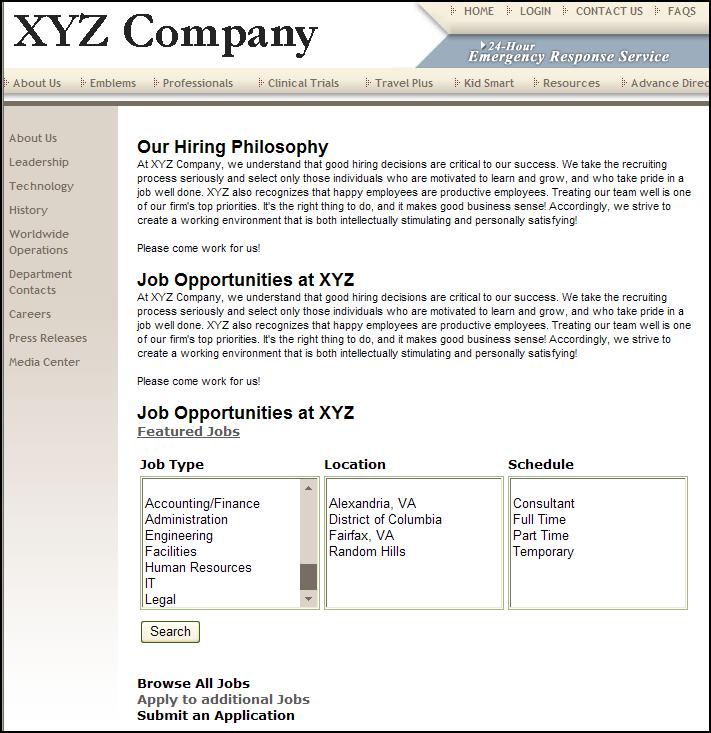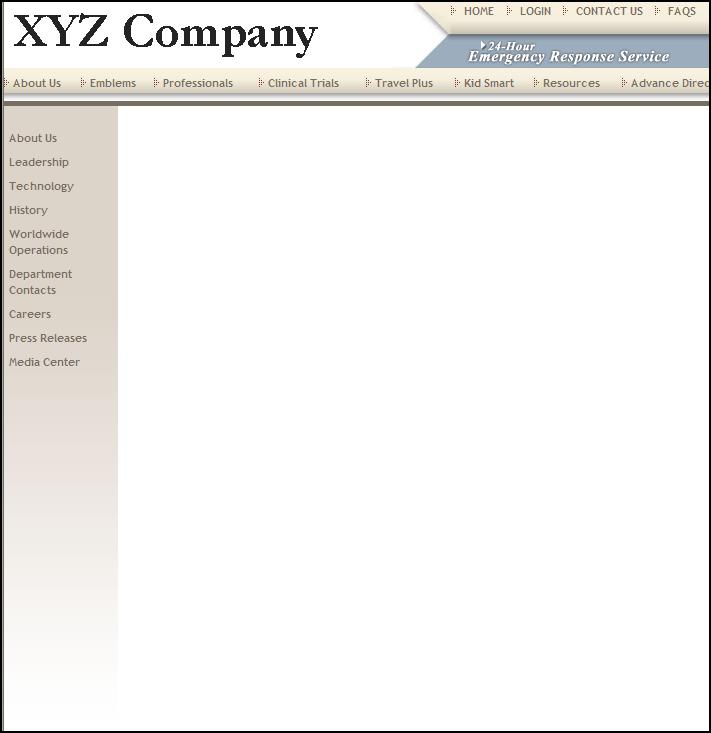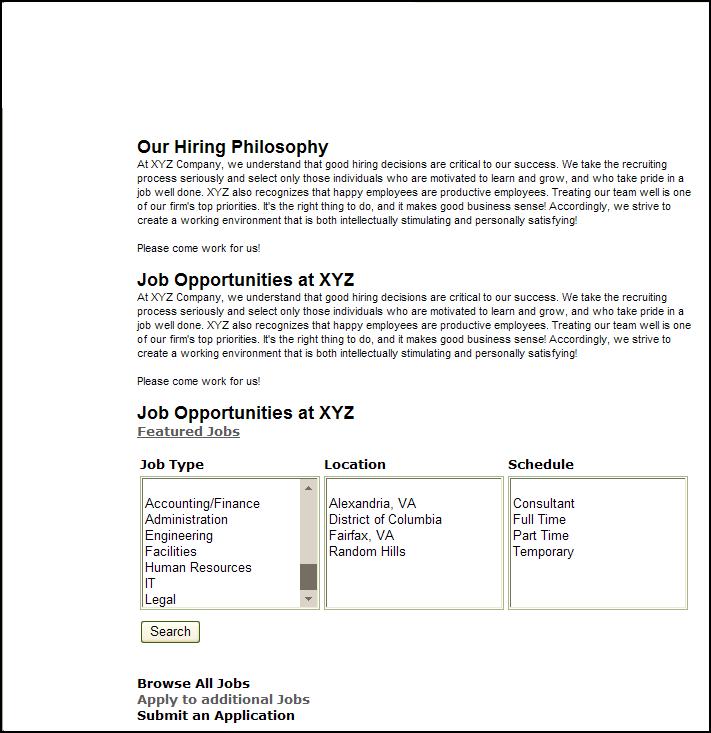Home > Guides > Technical Guide > xUnderstanding the Careers Component
xUnderstanding the Careers Component
Need Help on this Topic? Email Support
The purpose of this section is to provide full detail about what controls the website (external) section of Cyber Recruiter. This includes the Agency Portal, the Careers Portal, Self Service Modules, and the E-Offer process.
Cyber Recruiter's Careers module can be configured in two ways.
- You can have a branded site - This site is branded with your logo and is designed to showcase your open positions without the distraction of the rest of the corporate site. It can be modified to have the same background color and fonts as your corporate site while keeping the focus on the job search. Because this site has limited images and navigation it is ready to be mobile responsive.
- You can have a site with your corporate navigation - The site uses a template containing the navigation found on the corporate site to "frame" the content pulled from Cyber Recruiter.
More simply, websites can be somewhat confusing. How do I change a font? Where are field layouts modified? What is the difference between a style sheet and HTML codes? This section helps to breakdown the relationships among Cyber Recruiter, the company website, HTML editors and Style Sheets in an effort to help you to use the product to greatest capacity.
Terminology
There are certain technical terms used through implementation projects, tech support answers, and other documents related to maintaining the website. This guide will explain certain terms throughout and below are some important ones to get started (information below was adapted from http://en.wikipedia.org:
HTML editor (rad editor) allows non-technical users to manage HTML content easily. This product works like Word allowing many of the same capabilities for editing, inserting pictures or hyperlinks, and building tables.
Style Sheets are a way to organize and present HTML or XHTML content of a webpage in a centralized location. Cyber Recruiter style sheets are written in CSS (Cascading Style Sheets). Changing some things on the website (for example a font size) would have to be done on each web page to make the change consistently change through the whole website. With the Style Sheet, the font size could be changed in one place for the whole website.
ASP (Active Server Pages) uses the functionality of already built-in object groups. These established groups use common functionality to make the website more dynamic for the applicants. The out-of-box Careers website and Self Service are programmed as ASP.NET pages (.NET Active Server Pages) and are written in Visual Basic language.
SMTP (Simple Mail Transfer Protocol) is the server that Cyber Recruiter uses to deliver email messages. It requires an IP Address or an authenticated name to determine eligible relay messages. When email with Cyber Recruiter is not working this is one of the first places an Admin should test.
Web Server is a way to hold and exchange information among several people but keep the information in one central location. A Web Server connects the HTTP Users for the purpose of sending and receiving data. HTTP Users would be considered Applicants and Employees using the Career section of the website and/or Self Service section.
SQL Server is a relational database management system which stores alike data in forms of tables for easier access and efficient speed. For example, an Applicant could potentially provide Recruiters with a lot of information. Cyber Recruiter breaks down that information into various tables and connects them together using an Applicant Number so that the information can be quickly accessed as opposed to say a physical filing cabinet where the entire Applicant’s information is in one file in one location. Most business uses RDMS as it proves to be the best way to hold data.
Web Page Structure
Cyber Recruiter is designed to embed its controls into a template which can mirror the corporate website. This allows for a smooth transition from the corporate site over to the employment site which is dynamically linked to the administrative section of Cyber Recruiter. In order for this transparent transition to occur, a template is needed with all the elements of the corporate website which should be present in the employment section. Three pages are used for the website and typically all the pages have the same template but they can all be different.
- AgencyPortal.aspx - Controls the view of the Agency Portal view
- Careers.aspx - Controls the job searching and job description
- AppSelfService.aspx - Controls the online application, the Self Service module, and eOffer process
Templates
Below is an example of a website careers section utilizing Cyber Recruiter:

The Careers section of the website is broken into two (2) components.
The Background Template
The template is company specific and contains the structure of the page which will allow viewers to navigate to others sections of the website. Colors, style sheets, java scripting, RSS feeds, etc. can all be written into the frame of the page to make it look and feel like a website created by a web developer. When working to create a new site (regardless of the .aspx page being made) the first step is to generate this frame.
When submitting a frame, be sure to include ALL items which make the frame operate (not just an HTML picture of the frame) and make sure that the frame highlights the area of the website which is for employment. For example, if the current website highlights the word "Employment" when a viewer is in that section, make sure the frame also includes the correct attribute. When considering items related to the frame, ensure that any images are included with the structure and be sure that any scripting or RSS feeds reference links which can be accessed without issue from an SSL location.

The Cyber Recruiter Data
The center section of the page is controlled by Cyber Recruiter to pull job information to the website and allow applicants to apply to positions via the website. The content is easy to maintain and change within the product. However some of the formatting on the webpage is controlled by the Style Sheet rather the HTML editors within Cyber Recruiter so changing the settings will be done on the server by an IT professional.

Formatting
Formatting of the content displayed in the Cyber Recruiter controlled section of the website is determined by three different key components. The order of control is noted below.
- Cyber Recruiter Style Sheets. Each web page has a Cascading Style Sheet which controls key elements on the page (see the next section for details on the elements and aspects of control). If an element is NOT controlled by a Cyber Recruiter controlled Style Sheet, the program looks to...
- Wyswyg Editing Tools inside Cyber Recruiter. All of the web pages have text boxes where an administrator can control the content for messages on the pages. Text attributed defined in this section as "in-line" styles are referenced next. If a style is not specified OR if HTML code references another style sheet (H2 for example), the program looks to...
- Hard-Coded Styles or Style Sheets of the Frame. By default, if the program cannot find any other style to use, it will use the style noted in the frame or the style sheets sent with the frame. Typically this will be most noticable regarding URLs which are keyed into the text boxes, or line-heights used for the online application or if header's are used in the text boxes.
Frequently Asked Questions
Does Cyber Recruiter adheres to W3C Web Standards (accessible to all types of people with disabilities)?
Cyber Recruiter's career page is 508 compliant which does have a basis in W3C. But your website css would need to have all the correct style references. These were added some years ago but if the css file (which we don't update because it has styles specific to your website) wasn't updated then it might not have all the controlling keys.
Using the style sheet details above, have someone in IT do a comparison of your styles and what we have list and if there is anything missing, have them add it. The attributes can be whatever you need (different fonts, sizes, etc.) but the key is the name of the style.
|